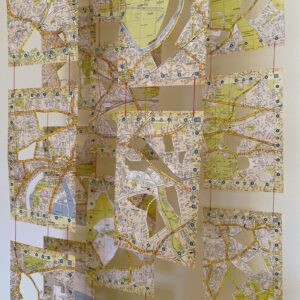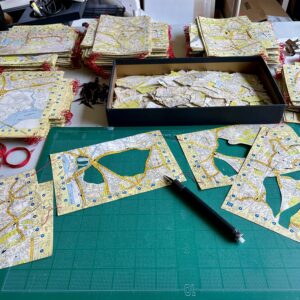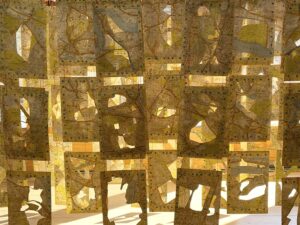For the artist Siân Robertson, physical borders are not a limit but an invitation to expand and play with perception. She works with old maps, carving up rivers, roads, bus routes, parks, and ponds with her X-Acto knife. Then, by further contorting the map’s form with acrylic, panel, and thread, Robertson reclaims a tool that has been rendered obsolete by time and technology.

“A map is not that great as a navigational device 10 years after it was made,” she says.
“In those 10 years, roads have changed, streets have gotten new names, buildings have gone away, new things have been built. Maps change all the time because the world changes all the time.”
This pragmatic fascination underlies Robertson’s current project, Impermanence, an installation for Twenty Summers at the Hawthorne Barn, 29 Miller Hill Road in Provincetown. It’s on view on Tuesday, May 21 and Wednesday, May 22; Robertson will give an artist talk Wednesday at 6 p.m.

Mobiles of used maps cut from copies of London A-Z, a book of street maps of the city, will hang from the barn’s ceiling in lengths of 5, 7, 9, and 11 pages. Robertson has altered each, connecting them with veins of red thread — a stark contrast to the map’s landscape of blues, yellows, and greens.
Using London A-Z as source material was an emotional decision as much as a practical one. Before she moved to the U.S. in 1992, Robertson, who grew up in Wales, lived in London. Every time she left her flat, she had the street maps with her as a guide.
Years later, after she had moved to the Outer Cape by way of San Francisco, London A-Z guided her in new creative directions. When she felt stuck, she says, she tore a page out of the book and started cutting out spaces. A conversation at a friend’s birthday party convinced her that the map itself held rich artistic potential.
Over the past decade, this map work has led to shows at Adam Peck Gallery in Provincetown and a residency at the Higgins Art Gallery at Cape Cod Community College. It has shifted in form and scale and geographic focus, ranging from a calendar of 365 three-by-three-inch shadow boxes to multidimensional acrylic renderings of the U.S. interstate highway system.

But Robertson hasn’t worked on a scale larger than a gallery wall. That changed when Alice Gong, the program director for Twenty Summers, visited Robertson’s home studio in Truro last year. Gong asked what Robertson would do if she had access to the Hawthorne Barn as an installation space.
“I always like to plant a little seed for the artists by asking, ‘What is the direction you like to move that you haven’t yet, or in what ways would you like to expand or change?’ ” says Gong.
Impermanence is new ground for Robertson, and those familiar with her earlier work recognize it.
“The maps are going to have a really diaphanous feeling to them and a vulnerable one,” says David Perry, an architect and exhibit designer who collects Robertson’s work. “Artists create things that are so precious. We put protective glass around art, but maybe there is a new way to look at it. For me, this is the strongest takeaway.”
Perry helped with the planning for Impermanence. So did Robertson’s friend, the artist Tim Horn. This was its own kind of puzzle. Because the Hawthorne Barn is a historic building, there are restrictions on hanging art from the rafters: no nails or screws allowed. The trio brainstormed how to get around this.

Balanced on ladders, they experimented and settled on using fishing line and pieces of lightweight garden trellis that had been cut into rectangular sections. In the lead-up to the installation, Robertson is tying each length of map to these support structures, which will hang from the rafters and cascade down.
“When you go and see an exhibition, it’s hard to visualize the sheer physical back story, the making of the work,” says Horn. “I think Siân’s process is such a big part of her work. It’s a daily practice for her, almost like a meditation.”
In the spirit of its name, Impermanence will be up only until May 22. During the two-day viewing, visitors will be able to touch the maps and bring home pieces of them in a kind of dialectic on the knife-edge of absence and presence: while the installation is altered by these encounters, its scope expands, reaching into pockets and psyches.
Robertson expects to be affected, too. “I think it’s going to be a really big lesson in letting go,” she says. “That’s part of why I’m doing it. You can’t call it ‘Impermanence’ and then protect it.”
Impermanence
The event: An installation, open house, and artist talk with Siân Robertson
The time: Tuesday, May 21, 2-7 p.m. and Wednesday, May 22, 10 a.m.-3 p.m., 5-7 p.m.
The place: Hawthorne Barn, 29 Miller Hill Road, Provincetown
The cost: Free; $20 suggested donation



